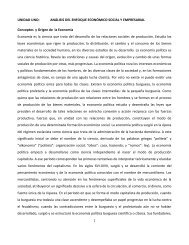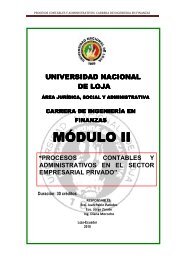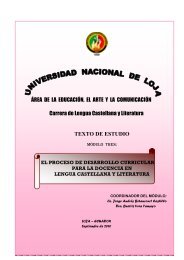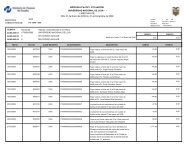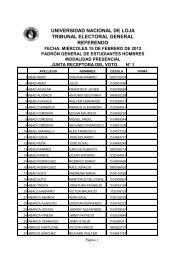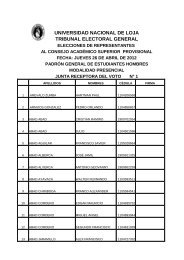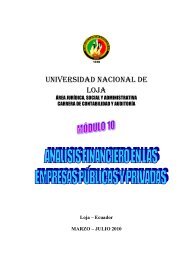module 5 planning of the english language teaching-learning process
module 5 planning of the english language teaching-learning process
module 5 planning of the english language teaching-learning process
Create successful ePaper yourself
Turn your PDF publications into a flip-book with our unique Google optimized e-Paper software.
UNIVERSIDAD NACIONAL DE LOJA<br />
Área de la Educación el Arte y la Comunicación<br />
English Language Career<br />
Teaching purpose: Why? Activity: What? Interaction pattern: How?<br />
Review students' knowledge<br />
<strong>of</strong> vocabulary and/or structure<br />
and <strong>the</strong> topic or context<br />
Brainstorming<br />
1.Groups: students to students<br />
(Ss ↔Ss)<br />
2.Feedback: students to<br />
teacher (Ss-T)<br />
Check students'<br />
understanding <strong>of</strong> new<br />
vocabulary<br />
Give students practice in<br />
scanning<br />
Bingo game<br />
Reading and filling in a<br />
chart<br />
Whole class: teacher to<br />
students (T→SS)<br />
1. Individuals<br />
2.Pairwork: student to student<br />
(S ↔ S)<br />
In our lesson plans we usually use short forms for showing interaction patterns,<br />
for example T -→ Ss' ra<strong>the</strong>r than writing out 'teacher to students'. We use 'S' to<br />
mean one student, and 'Ss' to mean more than one student.<br />
The second way in which <strong>the</strong> teacher groups students is when she decides<br />
which students will work toge<strong>the</strong>r in pairs, groups or teams. The teacher<br />
considers <strong>the</strong> students' levels, <strong>learning</strong> styles, learner needs, personalities and<br />
relationships with o<strong>the</strong>rs in <strong>the</strong> class before asking students to work toge<strong>the</strong>r.<br />
She needs to think which students will work toge<strong>the</strong>r best in order to learn best.<br />
<br />
Key concepts and <strong>the</strong> <strong>language</strong> <strong>teaching</strong> classroom<br />
When deciding how to group students, we need to consider a number <strong>of</strong><br />
different factors:<br />
• The <strong>teaching</strong> aim. It is much easier to choose how to group students when<br />
we have decided on <strong>the</strong> aim <strong>of</strong> <strong>the</strong> lesson and <strong>the</strong> aim <strong>of</strong> each activity.<br />
• The <strong>learning</strong> styles <strong>of</strong> <strong>the</strong> students. For example, some students prefer to<br />
work as individuals, o<strong>the</strong>rs in groups. Students also have different<br />
personalities and find it easier to work with some partners or groups than<br />
with o<strong>the</strong>rs.<br />
• The ability and level <strong>of</strong> <strong>the</strong> students. Most classes are 'mixed ability'/ i-e.<br />
<strong>the</strong>y include students <strong>of</strong> different abilities. We can group students for some<br />
activities so that students <strong>of</strong> <strong>the</strong> same ability work toge<strong>the</strong>r, and for o<strong>the</strong>r<br />
activities so that students <strong>of</strong> different abilities work toge<strong>the</strong>r.<br />
• The personalities <strong>of</strong> our students. Most <strong>of</strong> <strong>the</strong> time students will work well<br />
toge<strong>the</strong>r, but sometimes <strong>the</strong>re are students who do not work toge<strong>the</strong>r<br />
positively, e.g. when one student is shy and ano<strong>the</strong>r is quite dominant (i.e.<br />
always talking and stopping o<strong>the</strong>rs from taking part). We need to think<br />
carefully about how to group <strong>the</strong>se students.<br />
• The class size. With a class <strong>of</strong> between 20 and 30 students, we can manage<br />
pair and group work quite easily. With classes <strong>of</strong> more than 30 students, pair<br />
[Escribir texto] Página 104




